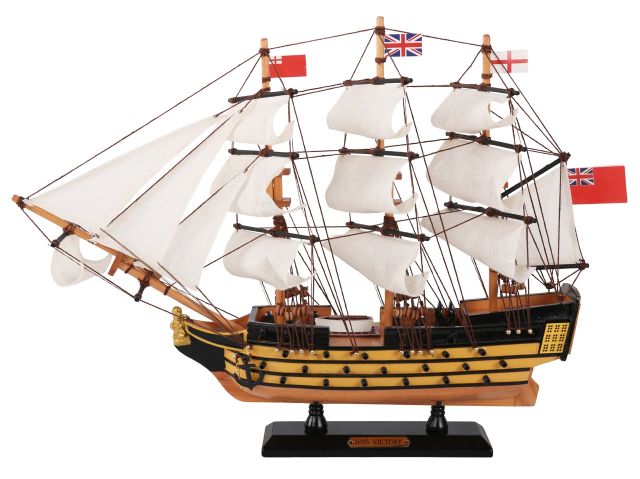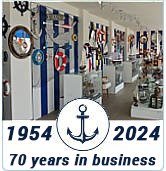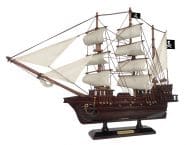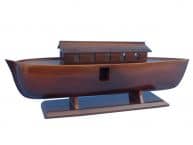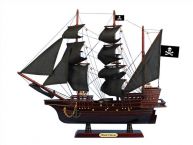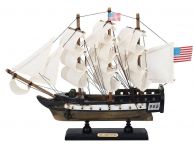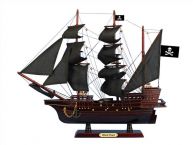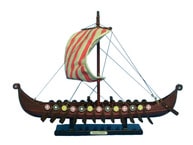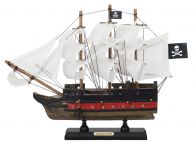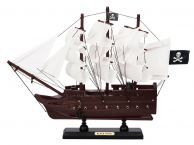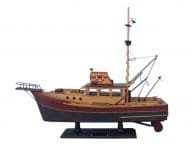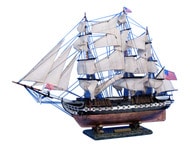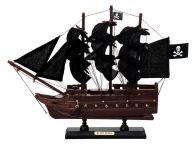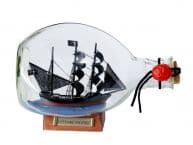|
|
Customers Also Shopped

|
|

|
Wooden HMS Victory Limited Tall Ship Model 15"
The Cutty Sark is a clipper ship. Built in 1869, she served as a merchant vessel (the last clipper to be built for that purpose), and then as a training ship until being put on public display in 1954. She is preserved in dry dock at Greenwich in London, but was damaged in a fire on May 21, 2007 while undergoing extensive restoration.
Etymology
The ship is named after the cutty sark (Scots: a short chemise or undergarment). This was the nickname of the fictional character Nannie (also the name of the ship's figurehead) in Robert Burns' 1791 comic poem Tam o' Shanter. She was wearing a linen cutty sark that she had been given as a child, therefore it was far too small for her. The erotic sight of her dancing in such a short undergarment caused Tam to cry out "Weel done, Cutty-sark", which subsequently became a well known idiom.
History
She was designed by Hercules Linton and built in 1869 at Dumbarton, Scotland, by the firm of Scott & Linton, for Captain John "Jock" "White Hat" Willis; Scott & Linton was liquidated, and she was launched November 22 of that year by William Denny & Brothers.
Cutty Sark was destined for the tea trade, then an intensely competitive race across the globe from China to London, with immense profits to the ship to arrive with the first tea of the year. However, she did not distinguish herself; in the most famous race, against Thermopylae in 1872, both ships left Shanghai together on June 18, but two weeks later Cutty Sark lost her rudder after passing through the Sunda Strait, and arrived in London on October 18, a week after Thermopylae, a total passage of 122 days. Her legendary reputation is supported by the fact that her captain chose to continue this race with an improvised rudder instead of putting into port for a replacement, yet was only beaten by one week.
In the end, clippers lost out to steamships, which could pass through the recently-opened Suez Canal and deliver goods more reliably, if not quite so quickly, which proved to be better for business. Cutty Sark was then used on the Australian wool trade. Under the respected Captain Richard Woodget, she did very well, posting Australia-to-Britain times of as little as 67 days. Her best run, 360 nautical miles (666 km) in 24 hours (an average 15kt, 27.75 km/h), was said to have been the fastest of any ship of her size.
In 1895 Willis sold her to the Portuguese firm Ferreira and she was renamed Ferreira after the firm, although her crews referred to her as Pequena Camisola ("little shirt", a straight translation of the Scots "cutty sark"). In 1916 she was dismasted off the Cape of Good Hope, sold, re-rigged in Cape Town as a barquentine, and renamed Maria do Amparo. In 1922 she was bought by Captain Wilfred Dowman, who restored her to her original appearance and used her as a stationary training ship. In 1954 she was moved to a custom-built dry-dock at Greenwich.
Cutty Sark is also preserved in literature in Hart Crane's long poem "The Bridge" which was published in 1930.
Museum ship
The Cutty Sark was preserved as a museum ship and popular tourist attraction. She is located near the centre of Greenwich, in south-east London, close aboard the National Maritime Museum, the former Greenwich Hospital, and Greenwich Park. She is also a prominent landmark on the route of the London Marathon. She usually flies signal flags from her ensign halyard reading "JKWS", which is the code representing Cutty Sark in the International Code of Signals, introduced in 1857.
The ship is in the care of the Cutty Sark Trust, whose president, the Duke of Edinburgh, was instrumental in ensuring her preservation, when he set up the Cutty Sark Society in 1951. The Trust replaced the Society in 2000. She is a Grade I listed monument and is on the Buildings At Risk Register.
Cutty Sark station on the Docklands Light Railway is one minute's walk away, with connections to central London and the London Underground. Greenwich Pier is next to the ship, and is served by scheduled river boats from piers in central London. A tourist information office stands to the east of the ship.
Conservation and fire
On the morning of May 21, 2007 the Cutty Sark, which had been closed and partly dismantled for conservation work, caught fire, and burned for several hours before the London Fire Brigade could bring the fire under control. Initial reports indicated that that damage was extensive, with most of the wooden structure in the centre having been lost.
In an interview with the chief executive of the Cutty Sark Trust it was revealed that at least half of the "fabric" (timbers, etc) of the ship is not on the site as it is being dismantled for the preservation work, and that they are most worried about the iron framework to which the fabric is attached.
Aerial video footage showed extensive damage but seems to indicate that the ship has not been destroyed in its entirety. A fire officer present at the scene said in a BBC interview that when they arrived, there was "a well-developed fire throughout the ship". The bow section looks to be relatively unscathed and the stern also appears to have survived without major damage. The fire seems to have been concentrated in the centre of the ship.
The Chairman of Cutty Sark Enterprises who has inspected the site said, "The decks are unsalvageable but around 50% of the planking had already been removed; however, the damage is not as bad as originally expected." It has already been stated that the ship can be restored, the damage being less than at first thought, and with up to half of the original materials currently being stored off-site during restoration. The chief executive of the Cutty Sark Trust did not know how much extra the ship would cost to restore, but estimated it at an additional £5–10 million, bringing the total cost of the ship's restoration to £30–35 million.
As part of the restoration work planned before the fire, it was proposed that the ship be raised three metres, to allow the construction of a state of the art museum space beneath. This would allow visitors to view her from below.
For a long time, there has been growing criticism of the policies of the Cutty Sark Trust and its stance that the most important thing was to preserve as much as possible of the original fabric. The fire damage has been put forth as a reason for the Cutty Sark to be rebuilt in a manner that would allow her to put to sea again by proponents of the idea. However, the Cutty Sark Trust have found that less than 5% of the original fabric was lost in the fire, as the decks which were destroyed were non-original additions. There are currently two petitions to the UK Prime Minister, one for funds to restore the ship, and the other for funds to restore the ship into commission as a sail training vessel.
In addition to explaining how and why the ship is being saved, the exhibition features a new film presentation, a re-creation of the master's saloon and interactive exhibits about the project. Live web-cam views of the conservation work allow the visitor to see remotely the work being carried out on the ship.
 Handcrafted
Handcrafted Handcrafted
Handcrafted Handcrafted
Handcrafted Handcrafted
Handcrafted Handcrafted
Handcrafted Handcrafted Model Ships
Handcrafted Model Ships


